|
|
|
Sort Order |
|
|
|
Items / Page
|
|
|
|
|
|
|
| Srl | Item |
| 1 |
ID:
103404
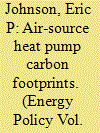

|
|
|
|
|
| Publication |
2011.
|
| Summary/Abstract |
European governments see that heat pumps could reduce carbon emissions in space- and hot-water heating. EU's Renewable Energy Directive designates heat pumps as renewable - eligible for various subsidies - if their carbon footprints are below an implied, average threshold. This threshold omits carbon generated by manufacture and emission of a heat-pump's fluorocarbon refrigerant. It also omits the footprint of the heat pump's hardware. To see if these omissions are significant, this study calculated carbon footprints of representative, residential heat pumps in the UK.
Three findings emerged. First, in relation to power generation, which accounts for most of a heat-pump's greenhouse-gas emissions, fluorocarbons add another 20% to the footprint. Second, at UK efficiencies a heat-pump footprint (in kg CO2e emitted per kWh delivered) is comparable or higher than footprints of gaseous fuels used in heating. It is lower than the footprint of heating oil and far lower than the footprints of solid fuels. Third, production and disposal of a heat pump's hardware is relatively insignificant, accounting for only 2-3% of the overall heat-pump footprint. Sensitivities to the results were assessed: key factors are footprint of electricity generation, F-gas composition and leak rates and type of wall construction.
|
|
|
|
|
|
|
|
|
|
|
|
|
|
|
|
| 2 |
ID:
094845


|
|
|
|
|
| Publication |
2010.
|
| Summary/Abstract |
Unilateral or sub-global policies to combat climate change are potentially sensitive to free-riding and carbon leakage. One way of dealing with carbon leakage and competitiveness is the imposition of border adjustment measures for competing imports, for example in the form of the obligation to importers of goods to purchase and surrender emissions allowances to the authorities when importing. In this paper, we explore some implications of border adjustment measures in the EU ETS, for sectors that might be subject to carbon leakage. We examine the implications of two variants of these measures on the competitiveness of these sectors and on the global environment with the help of a multi-sector, multi-region computable general equilibrium (CGE) model of the global economy. Our calculations suggest that border adjustment might reduce the sectoral rate of leakage of the iron and steel industry rather forcefully, but that the reduction would be less for the mineral products sector, including cement. The reduction of the overall or macro rate of leakage would be modest. So, from an environmental point of view border tax adjustments would not be a very effective policy measure, but might mainly be justified by considerations of sectoral competitiveness.
|
|
|
|
|
|
|
|
|
|
|
|
|
|
|
|
| 3 |
ID:
174230
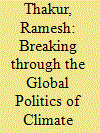

|
|
|
|
|
| Summary/Abstract |
In preparation for the UN discussions in September and the Madrid climate conference in December, a spate of reports warned that the natural environment and ecological systems that sustain all forms of life are collapsing. 1 Laurie Laybourn-Langton, lead author of a report from the Institute for Public Policy Research (IPPR) in February 2019, wrote that “the environment is breaking down, with consequences which include more drought, famine, forced migration and war. Environmental breakdown poses a catastrophic risk.”
|
|
|
|
|
|
|
|
|
|
|
|
|
|
|
|
| 4 |
ID:
100353
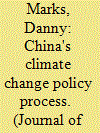

|
|
|
|
|
| Publication |
2010.
|
| Summary/Abstract |
China has recently become the world's largest emitter of carbon and is already facing many harmful effects domestically from climate change. Chinese leaders have therefore made a high-level commitment to curb emissions, as evident in the 2007 National Climate Change Program. However, the government has missed many of its targets, in particular its goal of reducing energy intensity. This essay argues that China is missing its targets because of a number of factors which stem from the fragmented nature of China's authoritarian system. First, environmental policies are too broad and complicated, making it difficult for regulators to enforce the laws. Second, the current incentive structures of promotion and salary cause local officials to give higher priority to economic development than to environmental issues. Third, environmental regulators, such as the judiciary and environmental agencies, remain weak and impeded by enforcement obstacles. While positive changes have occurred, such as the emergence of NGOs and the media as environmental watchdogs and a burgeoning clean technology sector, much remains to be done to improve the long-term viability of climate change policies in China. Based on the preceding analysis, this essay recommends ways by which the government could improve the process of enacting and implementing climate change policies. It also urges the international community to sympathize with the Chinese government and, by leading the way, help the government gain greater compliance with climate change policies.
|
|
|
|
|
|
|
|
|
|
|
|
|
|
|
|
| 5 |
ID:
134359
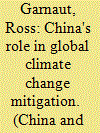

|
|
|
|
|
| Summary/Abstract |
China contributed a majority of the growth in global greenhouse gas emissions in the first 11 years of this century. The trajectory of emissions has changed radically since then, as China has implemented its Cancun 2010 commitment to reduce the 2005 emissions intensity of economic activity by 40–45 percent by 2020. The change in trajectory has been reinforced by China's new model of economic growth, with its greater emphasis on equity in income distribution, consumption and services. The large-scale deployment of low emissions technology in China is lowering the cost of transition to a low carbon economy all over the world. China's new emissions trajectory improves the opportunity for the international community to meet the 2°C climate target. It is essential that the changes in China are brought to account in shaping global mitigation ambition.
|
|
|
|
|
|
|
|
|
|
|
|
|
|
|
|
| 6 |
ID:
093611
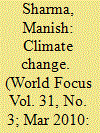

|
|
|
| 7 |
ID:
088950
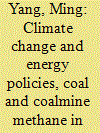

|
|
|
|
|
| Publication |
2009.
|
| Summary/Abstract |
The Chinese government has made many energy policies on coal, and coalmine methane (CMM) use. However, not all of these policies have effects or positive impacts. For example, it has been quite a few years since the national government made policies to encourage coalmine methane power to be sold to the grid. Practice showed that not any kilowatt of electricity was sold from a coalmine methane power plant to the grid in Sichuan and Guizhou Provinces as of December 2008. The objectives of this paper are to review and evaluate the Chinese government energy and climate policies that are related to coal and coalmine methane, analyze relevant policy barriers, and make recommendations to overcome these barriers and avoid policy failures. This paper provides the literature review, challenges, resources, policies and other updated information on China's CMM recovery and utilization. The paper concludes that China needs to further reform its energy and environment management system, engage provincial governments in CMM capture and use activities, and provide incentives to qualified engineers and skilled workers to work in remote coal mining areas. This paper transfers key messages to policy makers for them to make better CMM capture and use policies.
|
|
|
|
|
|
|
|
|
|
|
|
|
|
|
|
| 8 |
ID:
095335
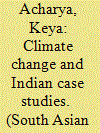

|
|
|
| 9 |
ID:
186443


|
|
|
|
|
| Summary/Abstract |
Carbon prices and carbon caps need to be set at levels that will deliver the reduction targets necessary to keep global warming under 2 °C, aspiring to 1.5 °C above pre-industrial levels, in line with the Paris Agreement. Given both the urgency of the situation and the heterogeneity across countries and sectors, switching caps and switching prices may be the answer.
|
|
|
|
|
|
|
|
|
|
|
|
|
|
|
|
| 10 |
ID:
173477
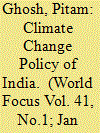

|
|
|
|
|
| Summary/Abstract |
Climate change is one of the complex problems facing mankind today. The overriding complexity of the problem is attributed to its deeper global ramifications on a vast range of issues impacting the very survival of life on Earth.
|
|
|
|
|
|
|
|
|
|
|
|
|
|
|
|
| 11 |
ID:
132668
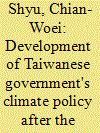

|
|
|
|
|
| Publication |
2014.
|
| Summary/Abstract |
Given its limited involvement in and recognition by international organizations, Taiwan is not presently a signatory to the United Nations Framework Convention on Climate Change (UNFCCC) or the Kyoto Protocol. The objective of this study is to analyze how and the extent to which changes in an exogenous factor, namely the Kyoto Protocol and Post-Kyoto climate negotiations, affect and ultimately lead to the formulation of and changes in the Taiwanese government×s climate policy. This study applies policy network theory to examine the development of and changes in the Taiwanese government×s climate policy. The results demonstrate that international climate agreements and negotiations play a key role in the development of, changes to, and transformation of Taiwan×s climate policy. Scarce evidence was found in this study to demonstrate that domestic or internal factors affect climate change policy. Despite its lack of participation in the UNFCCC and the Kyoto Protocol, Taiwan has adopted national climate change strategies, action plans, and programs to reduce greenhouse gas emissions. However, these climate policies and measures are fairly passive and aim to only conform to the minimal requirements for developing countries under international climate agreements and negotiations. This process results in inconsistent and variable climate policies, targets, and regulations.
|
|
|
|
|
|
|
|
|
|
|
|
|
|
|
|
| 12 |
ID:
176763
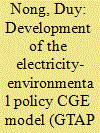

|
|
|
|
|
| Summary/Abstract |
A new carbon price mechanism with full emission coverage is developed within the framework of a global computable general equilibrium model (GTAP-E-PowerS) to enhance the capacity and accuracy for climate change and energy policy assessment. The model developed is then used to examine the potential impacts of the carbon tax in South Africa. Results show that incorporation of non-CO2 emissions in the model significantly alters the results of which the economy of South Africa experiences higher costs compared to the case that only has CO2 emissions. When more sectors are included in the policy it also puts higher costs on the economy, as higher levels of emissions are subject to the carbon tax. Results also show that South Africa only experiences small tradeoffs from introducing the carbon tax in all scenarios. That is, with a tax rate of $9.15, the country is able to reduce its emission levels by 12.25%–15.6% at the costs of real GDP reduction by 1.17%–1.59%. Fossil-based industrial sectors are particularly worst off, while clean and renewable energy sectors strongly expand their production. The results indicate that South Africa is likely to move to a low carbon and sustainable economy with such a policy.
|
|
|
|
|
|
|
|
|
|
|
|
|
|
|
|
| 13 |
ID:
128451


|
|
|
|
|
| Publication |
2014.
|
| Summary/Abstract |
This article assesses the reasons for observed differences in greenhouse gas (GHG) emissions among high-income OECD countries. Nine factors were tested: climate, population pressure (measured as both growth and density), economic output per capita, technological development, industrial structure, energy prices, environmental governance, pollution abatement and control expenditures, and environmental pricing. Based on a series of regression analyses, three factors - energy prices, economic output per capita, and environmental governance - were identified as the most important factors for explaining differences in OECD per capita GHG emissions. Combined, these three factors explain about 81% of the variation observed in OECD per capita GHG emissions. Individually, energy prices explains about 55% of the variation in per capita GHG emissions, while economic output per capita explains about 19%, and environmental governance about 7%. These findings show that behavioural choices based on existing technologies, rather than exogenous factors such as climate, determine differences in GHG emissions and, therefore, policy options to change behaviour such as increasing energy prices and other regulatory changes have the potential to significantly reduce GHG emissions.
|
|
|
|
|
|
|
|
|
|
|
|
|
|
|
|
| 14 |
ID:
119832
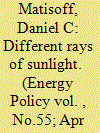

|
|
|
|
|
| Publication |
2013.
|
| Summary/Abstract |
This study assesses the effectiveness of two types information disclosure programs - state-based mandatory carbon reporting programs and the voluntary Carbon Disclosure Project, which uses investor pressure to push firms to disclose carbon emissions and carbon management strategies. I match firms in each program to control groups of firms that have not participated in each program. Using panel data methods and a difference in differences specification, I measure the impact of each program on plant-level carbon emissions, plant-level carbon intensity, and plant level output. I find that neither program has generated an impact on plant-level carbon emissions, emissions intensity, or output. Placing this study in contrast with others that demonstrate improvements from mandatory information disclosure, these results suggest that how information is reported to stakeholders has important implications for program effectiveness.
|
|
|
|
|
|
|
|
|
|
|
|
|
|
|
|
| 15 |
ID:
183582


|
|
|
|
|
| Summary/Abstract |
With firm-level panel data for seven years, this study evaluated the effect of carbon pricing policy and analyzed how firms respond to the carbon price, focusing on Korea's Emission Trading Scheme (ETS). Under the assumption that firms' responses to the carbon price might differ across industries, this study compared the manufacturing and electricity generation sectors. Our panel regression analyses show that the ETS has significant impacts on firms' carbon reduction. However, the carbon reduction mechanisms of firms differ by industrial sector. Firms in the manufacturing sector reduced carbon emissions by improving the energy efficiency of their facilities. On the other hand, those in the electricity generation sector reduced emissions by phasing out the use of fossil fuels and by giving more weight to low carbon-intensive energy sources. These findings imply that carbon pricing works as designed, sending economic signals for firms to decarbonize their economic activities. Furthermore, it works differently (and so effectively) according to the industry's characteristics.
|
|
|
|
|
|
|
|
|
|
|
|
|
|
|
|
| 16 |
ID:
169880
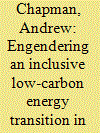

|
|
|
|
|
| Summary/Abstract |
Engendering a low-carbon energy transition is necessary to limit climate change impacts and temperature rises. Ideally, this transition would be inclusive, incorporating all stakeholders, however, the issue of energy or fuel poverty is a major obstacle to this goal. This research investigates energy poverty in Japan using a subjective, multidimensional energy poverty measure, clarifying the linkages between energy poverty and an inclusive, just transition in terms of energy system and policy awareness, behavior and preferences. Through the analysis of an original survey, we uncover that there is a marked difference between low-income and energy poverty households’ environmental awareness, and their subsequent attitude toward the low-carbon energy transition. Currently, the energy poor have a negative attitude toward the low-carbon energy transition in Japan, causing a lack of self-reported engagement which will not engender an inclusive, just transition. Our findings suggest that if the Japanese low-carbon energy transition were to be inclusive, a further 5 percent of households could participate in the low-carbon energy transition through access to solar or renewable energy capital. Findings identify the need for policies targeted at the energy poor, specifically promoting access to solar capital and low-carbon technologies, in addition to existing policies targeted at low-income households.
|
|
|
|
|
|
|
|
|
|
|
|
|
|
|
|
| 17 |
ID:
176764
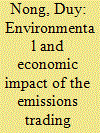

|
|
|
|
|
| Summary/Abstract |
This study aims to fill a gap in the literature by examining the impacts of an emissions trading scheme (ETS) in Vietnam, as the policy has been discussed for a decade in the country but the likely impacts on the economy and different sectors are still unidentified. The simulations are carried out in a global energy computable general equilibrium (CGE) model, an extension of the GTAP-E model, which treats Vietnam as a country region. Results show that restricting the number of industrial sectors in the emissions trading market substantially affects the country's economy with a decline in real GDP by 4.57%. However, the country experiences much smaller adverse impacts (e.g., real GDP declines by 1.78%) when all industries participate in the emissions trading market. In either case of the ETS design, the coal mining, manufacturing, transportation, and electricity sectors are highly adversely affected; however, the crude oil and natural gas extraction sectors would experience expansion in their production levels due to substitutions for coal. In general, under the policy the emission levels from burning fossil fuels decline at significant rates, particularly from the electricity generation sector.
|
|
|
|
|
|
|
|
|
|
|
|
|
|
|
|
| 18 |
ID:
111328


|
|
|
|
|
| Publication |
2012.
|
| Summary/Abstract |
EU's objective of attaining 20% reductions in greenhouse gas emissions by 2020 is analysed with a general equilibrium model detailing electricity generation technologies and capital vintaging. Consistent with theory and other analysts we find that the nonuniform treatment of emitting sectors in EU raises abatement costs - by a factor of two to three. Under cost effective emission reductions - a more comprehensive tradable cap-electricity generation abates more than its proportional share in emissions. The European economy abates by substitution towards natural gas, by energy efficiency improvements, and by reductions in emission intensive manufactures. Applied policies such as renewable support - and responses such as carbon leakage - hold down the prices for emission and electricity, thus also holds down incentives for energy efficiency and technological change. This leads to little preparation for the future and global mitigation.
|
|
|
|
|
|
|
|
|
|
|
|
|
|
|
|
| 19 |
ID:
135452
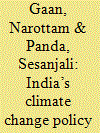

|
|
|
|
|
| Summary/Abstract |
India has a distinctive vulnerability profile as the poor are the most affected. Tremendous weather events take place more frequently and are becoming more ruthless. Therefore the previous attempts of just rescuing the affected will not be enough now, instead, meticulous steps to prevent these disasters are required. This can only be met if the strategies and policies can cope with climate change, requiring the active participation of the government and the people.
|
|
|
|
|
|
|
|
|
|
|
|
|
|
|
|
| 20 |
ID:
191300
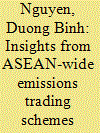

|
|
|
|
|
| Summary/Abstract |
ASEAN has not yet had any joint policy to constrain emission levels in the context of global efforts to tackle climate change and studies on such issues in the region are still scarce. This study employs a global computable general equilibrium (CGE) climate change policy-focused and electricity-detailed model to examine the impacts of emissions trading schemes (ETSs) on the ASEAN member economies. We found that Indonesia (a permit buyer) experiences much lower economic costs in the regional ETS scenarios rather than in its closed ETS market (−9% compared to −16% in real GDP). Malaysia, the Philippines, Singapore, Thailand and Vietnam act as permit sellers and experience higher economic costs in the regional ETS scenarios. It is because the balance on the current account, which is equal to the sum of the ordinary trade balance and net emissions trading revenue, is assumed to be fixed. Furthermore, the change in ratio of trade balance to regional income is also fixed. Such a setting indicates that if the net permit trading revenue is used to fully compensate for the trade balance, which is also maintained along with the changes in the regional income, permit selling countries will be worse off and vice versa if they move from their domestic ETS markets into a regional ETS market. Results also show that technological improvements can help reduce economic costs of the ETSs. In addition, renewable energy sources show strong expansions in their production levels, but they are still far from becoming dominant in ASEAN in order to significantly reduce economic costs of climate change policies. Households will also increase their demand for renewable energy in all ASEAN countries while lowering demand for fossil-based energy; however, this sector will still experience reductions in the overall electricity demand due to previous strong reliance on fossil-based energy.
|
|
|
|
|
|
|
|
|
|
|
|
|
|
|
|
|
|
|
|
|